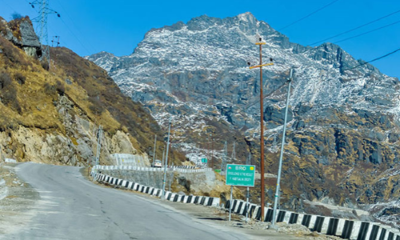Context-
The Indian Ministry of Defense's Year End Review for 2023 provides a comprehensive overview of various aspects under its purview, ranging from defense production and exports to major acquisitions and border infrastructure. Notably, the focus on border infrastructure gains significance against the backdrop of evolving Sino-Indian relations and the strategic imperative to enhance military capabilities along the shared border.
Historical Context:
The heightened attention on border infrastructure is rooted in the historical context of Sino-Indian relations and the increasing military prowess of China. While the 2020 Year End Review specifically emphasized China's aggressive behavior following the Galwan clash, subsequent reviews have taken a more general approach, reflecting a broader assessment of major developments within the Indian Ministry of Defense.
Military Imbalance and Infrastructure Race:
The review acknowledges a noticeable military imbalance between India and China, particularly concerning defense platforms, military units, and physical infrastructure. China's extensive investment in state-of-the-art infrastructure along the border and the Tibetan Autonomous Region has afforded them a significant advantage in terms of troop mobilization. The vast road network and rail links in Tibet, coupled with oil and logistic depots along the border, contribute to China's strategic flexibility, placing India at a disadvantage.
Indian Infrastructure Development:
In response to the perceived infrastructure gap, India has intensified efforts to upgrade its border infrastructure. The 2023 review highlights that the Indian Defense Minister dedicated a total of 118 infrastructure projects led by the Border Roads Organization (BRO). While these projects span the entire country, a substantial number are concentrated in the Sino-Indian border areas, including Arunachal Pradesh, Ladakh, Jammu & Kashmir, Mizoram, Himachal Pradesh, Sikkim, Uttarakhand, West Bengal, and Nagaland.
Projects and Initiatives:
The detailed appraisal of the infrastructure projects underscores a multifaceted approach. The projects include the construction of tunnels, airfields, helipads, roads, and bridges. Notable examples include the Nechiphu Tunnel in Arunachal Pradesh, the Raqni-Ustad-Pharkiyan Gali road in Jammu and Kashmir, and the Sela tunnel on Balipara-Chariduar-Tawang Road in Arunachal Pradesh. The BRO has initiated work on 20 tunnels, with 10 under construction and 10 in the planning stage.
Road Development:
The review outlines significant progress in road development, with 601 kilometers of roads completed during the year. Emphasis is placed on critical roads along the Northern Borders, such as Nimu-Padam Darcha road, Gunji-Kutti-Jolingkong road, and Balipara-Chardwar-Tawang road. Ongoing projects, including the Raqni-Ustad-Pharkiyan Gali road and the Srinagar-Baramulla-Uri road, are nearing completion, addressing key connectivity challenges.
Tunnels and Bridges:
Infrastructure initiatives include the construction of tunnels and bridges, essential for enhancing mobility and connectivity. The Shinku La Tunnel on the Nimu-Padam-Darcha road in Ladakh, the Sela Tunnel in Arunachal Pradesh, and the Kandi Tunnel in Jammu and Kashmir are noteworthy projects contributing to all-weather connectivity and strategic advantages.
Telemedicine and Technological Integration:
The government's focus extends beyond physical infrastructure to include technological advancements. Three telemedicine nodes have been established, enhancing healthcare capabilities in Ladakh and Mizoram. Additionally, the incorporation of technology in infrastructure projects reflects a commitment to leveraging the best available tools for efficient and timely completion.
Financial Allocation and Budget:
Recognizing the strategic significance of infrastructure development, the BRO's budget has reached a record high of Rs 12,340 crore in FY 2022-23. This marks a 100% increase in funds allocated under the GS Capital Head over the preceding two years, reaching Rs 5,000 crore. The substantial financial boost underscores the government's commitment to addressing infrastructure gaps.
Strategic Imperative Amid Bilateral Tensions:
The increased focus on border infrastructure aligns with the imperative to strengthen India's strategic position amid ongoing tensions with China. Since the Galwan conflict in 2020, there has been a concerted push to accelerate infrastructure development, positioning troops and military supplies closer to the border. This shift reflects a departure from India's historical defensive approach to infrastructure development.
Comparison with China's Infrastructure:
While India's efforts are commendable, a comparative analysis with China's two-decade-long push reveals existing disparities. China's modern road and railway networks in Tibet and the Sino-Indian border areas have set a precedent for the level of infrastructure required for strategic dominance. India's recent initiatives represent a crucial step, but sustained efforts are needed to bridge the existing gap fully.
Conclusion:
The Indian Ministry of Defense's Year End Review for 2023 provides a detailed account of the nation's endeavors to fortify its strategic border infrastructure. Against the backdrop of evolving Sino-Indian relations, these efforts signify a proactive approach to address historical imbalances. While progress has been made, the journey towards achieving parity with China's infrastructure capabilities is ongoing. The comprehensive strategy, encompassing road development, tunnels, bridges, and technological integration, reflects a commitment to bolstering national security and defense preparedness. As India continues to navigate complex geopolitical dynamics, the strategic significance of robust border infrastructure cannot be overstated.
|
Probable questions for UPSC Mains Exam- 1. Analyze the key factors contributing to the heightened focus on border infrastructure in India. Discuss how this strategic imperative is influenced by the evolving dynamics of Sino-Indian relations. (10 Marks., 150 Words) 2. Assess the progress and significance of India's efforts to upgrade its border infrastructure. In what ways do these infrastructure developments address the historical military imbalance between India and China, especially considering the extensive investments made by China in the region? (15 Marks., 250 Words) |
Source- ORF







